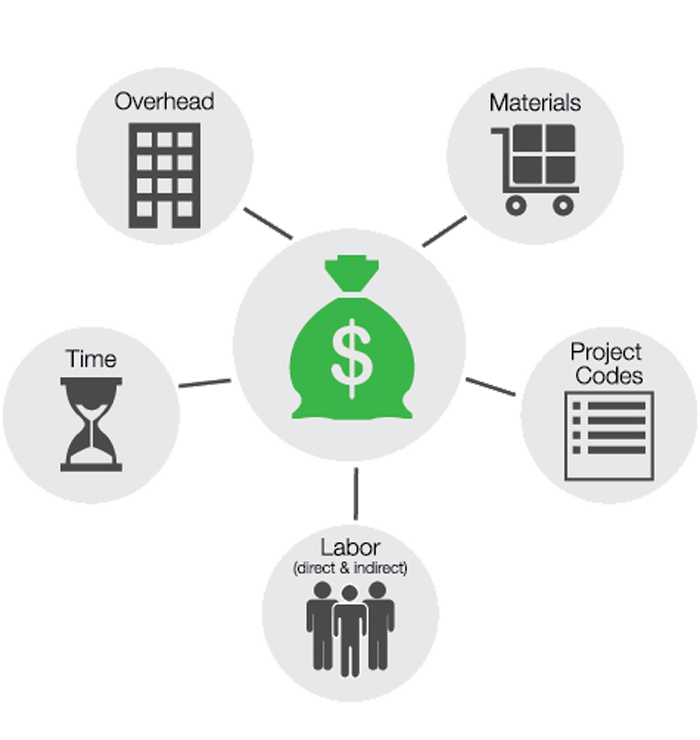Job Costing Is designed for any business which charges on the basis of time, material, labor and other costs. It is a powerful tool for business analysis, as it enables estimating the costs of jobs & projects, issuing client quotations, controlling the cost spent and generating the invoices.
It monitors at a glance how much was spent on each job such as material used, time logged by personnel and local purchases directl allocated, related suppliers orders (LPOs), history if estunates/ quotations and other critical job information. While that applies to any business in the servicing industry, Visual Dolphin Job Costing is particularly flexible to adapt to some specific business tyoes. Companies that do cost estimations and operations based on time billing services and professionals.


Job cost accounting is vital for any business that provides firm bids or other price quotes before doing work, By tracking costs for each job, it is possible to see how accurate the original estimate was. Visual Dolphin job costing features are well suited for the following types of estimate-based businesses. Production houses, printing, advertising agencies, PR services, events organizers, consulting firms, lawyers, copy centers and other business in the servicing industry that do bids or estimates.
Because job costing is so good at tracking billable costs, it workds well for servicing businesses and professionals that bill their services on an hourly or “time and materials” basis.
On the other hand, it also offers a solid system for billing based on surveyed accomplishments.
- Design work breakdown structures that are unique to a project
- Define project brief and attach unlimited number of documents (scanned, CSV, Word, Excel, PDF…)
- Various billing methods: Full or partial amounts, based on delivered or based on time and services spent
- Define the cost estimate including supplier’s preliminary quotations, BOM (Material used, Labor, Local purchases, Outsourced tasks, subcontracting, Equipment…)
- WIP: Allocate costs & charges related to the Job/Project: Time sheet, Material, Outsourcing/Sub contracting, Local purchases, Equipment, Cash expenses, Financial expenses…
- Measure at a glance how much was spent on each job such as costing information, materials used and time logged by personnel…
- Analyze job performance using powerful, flexible and multi-criteria reporting and graphical analysis
A proper job definition is the key to accurate job cost accounting. The job definition identifies the job, the preferred billing mode and the workflow cycle it has to respect. Relevant documentation to the job can be attached to the job and retrieved for future reference.
The financial status of the job is always maintained up-to-date. At any time, the budget estimate, the total value of the job, the amount billed to date and the real cost of the job can be checked online.
To be able to quote a job, its billable components should be broken down up to the lowest element that constitutes the job. In Visual Dolphin Job Costing, a four level hierarchy allows the allocation of cost at the level of a job, a sub-job, a cost element or a sub-cost element. The sub-cost element being considered the lowest billable level; additional technical description can be entered at this level.
A cost element should be considered as a definition of the bill of material since its cost sums all various expenses related to the achievement of this particular job component. For example, for a printing job, a cost element may include expenses related to printing, color separation, labor…
In Visual Dolphin Job Costing, a user can add a mark up on the overall cost and even include the company fees per cost element, by value or percentage. Several discounts can be combined and set per job.
When done, the quotation is generated using several user-defined layouts. Visual Dolphin Job Costing keeps track of the different versions issued as reference. A specific quotation for a client can be even saved as a template for future use.

Visual Dolphin Job Costing proposes four different billing modes:
- Normal mode; where the invoices are issued totally or partially
- By percentage of accomplishment; invoicing is related to the job progress and consequently invoices are issued based on the percentage achieved
- Retainer fee; this is very common to servicing companies that issue maintenance fees monthly, yearly or another frequency
- Time & service billing; invoices are issued on the actual time or expenses spent on the project, and not based on any initial quotation.
Visual Dolphin Job Costing includes a workflow functionality that helps you define the cycle through which the job has to go to get its final approval. Notes can even be exchanged between actors to improve communication and turn the office to paperless environment!
Tasks can also be created at the level of each line in the quotation and assigned to different users to carry out some duties with specific details. Managers can follow up on the status of these tasks from a monitoring screen.
Visual Dolphin Job Costing includes the entry of surveys for the quantities accomplished out of the planned/ estimated ones and therefore, allows to invoice what was surveyed partially or totally.
Visual Dolphin Job Costing interacts with the stock modules for managing the material required for a job. A request for purchase order is generated from the job costing for the material specified in the job for the quantities that are not available in stock. From there, these RPOs can be issued as POs and hence, purchased into a warehouse. As for the quantities available in stock, these can be booked for the job from job costing.
A material pick list is prepared for the items that are to be delivered to the project from the stock warehouse and then the material In/ Out will render them consumed to the job and add their cost to the job total expenses.
During the job’s estimation or execution phase, third party vendors come into stage to offer cost values for the estimation or purchase orders to outsource services or subcontract tasks.
In Visual Dolphin Job Costing, this is done in the purchase requisition that can be set for pricing or purchasing purposes. This tendering function issues several requests for quotation (RFQ) to different suppliers. It tracks and compares the proposals submitted by the different suppliers before preparing the final services PO to the suppliers selected for the job.
Control can even be tightened at the system level to accept invoices from suppliers with amounts that match the original PR only.
During job execution, all expenses related to the job are allocated to the work in progress accounts. Expenses include the local purchases from suppliers, labor cost from the employees’ time sheet, the cost the equipment used for the project. At any time, the real cost of the job can be checked and compared to the initial estimate.
At job end or when a project is delivered, the expenses are removed from the WIP accounts and reallocated to the overall project cost.
The usage of a standard reporting tool provides the required flexibility to produce effective reports and enables the users to export all report data to an external file, utilizing most of the standard supported data types, like ASCII, Rtf or Excel.
Selection of Job Costing Reports
- Comparison between active and previous job
- Yearly sales comparison
- Monthly sales
- Time and service billing reports
- Supplier payables
- Time sheet reports
- Material required for jobs
- Margin analysis by cost element
- Cash flow reports
- Wip aging
- Cost accrual
- Cost control per job
- Cost analysis per job
- Cost control
Visual Dolphin Job Costing offers a set of inquiries that are used to monitor entries and control operations at any level. These are provided by a set of inquiry grids and drilling down to the actual transactions is possible. Various filtering criteria, grouping, viewing and monitoring options are given to the user to filter the data to be studied.
Like any other Visual Dolphin product, Visual Dolphin Job Costing ensures that right to use all crucial business processes is secure.
Security groups are created to restrict users’ access to specific functions or programs: a handler is given a limited access to the institution jobs; he can only view his allocated jobs.
Staff in a branch part of a multi-branch organization has access to the branch jobs but not the whole organization.
Access limitations can even be defined at the level of certain fields in Visual Dolphin Job Costing where, for example, a production manager can see the cost but not the sales conditions while a sales manager sees the sales but not the cost.
